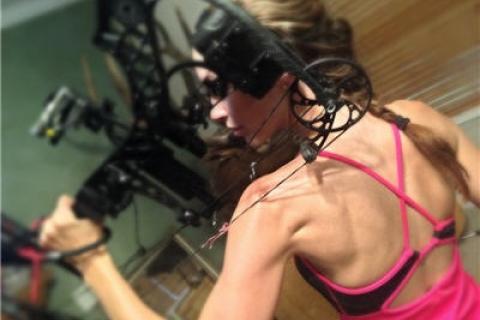
We spend countless hours — and much of our paychecks — on outdoor activities like hunting and fishing. So when we get to a remote location, the last thing we need is to feel too winded and worn out to enjoy it. During the years I’ve spent hosting, filming, and producing outdoor television, I’ve learned a few key exercises that have helped me prepare for real world hunting situations. These workouts are great for those who would rather spend their money on outdoor gear than a gym membership.
 1. Good old-fashioned cardio. None of us really enjoy spending time on a treadmill but if that’s the only way you can get your heart rate up for 20 to 40 minutes a day, then you should find a way to power through it. My favorite form of cardiovascular exercise are Tabata drills. It’s an intense form of interval training that requires strength and stamina. You can customize your workouts based on your level of fitness, fitness goals and available time. A heart rate monitor or sports watch can help you track your progress.
1. Good old-fashioned cardio. None of us really enjoy spending time on a treadmill but if that’s the only way you can get your heart rate up for 20 to 40 minutes a day, then you should find a way to power through it. My favorite form of cardiovascular exercise are Tabata drills. It’s an intense form of interval training that requires strength and stamina. You can customize your workouts based on your level of fitness, fitness goals and available time. A heart rate monitor or sports watch can help you track your progress.
![]() Suggested Tabata Exercise: Think jumping or moving for 20-30 seconds at full strength, and then resting for 10 seconds. Some examples are: jumping jacks, rest; mountain climbers, rest; squat jumps, rest; and repeat three times. Your heart rate will definitely be up!
Suggested Tabata Exercise: Think jumping or moving for 20-30 seconds at full strength, and then resting for 10 seconds. Some examples are: jumping jacks, rest; mountain climbers, rest; squat jumps, rest; and repeat three times. Your heart rate will definitely be up!
2. Core exercises. Your core is where all of your strength comes from when you’re lifting, hiking, drawing your bow back, or loading a deer into a truck bed. Sure, it helps to have upper body strength in general but having a strong core will give you better posture and better payload capacity from your upper body and back. Best part? No equipment is needed.
![]() Example Core Exercise: Planks – Assume a modified push-up position with your elbows bent 90 degrees and both forearms resting on the floor. Keep your elbows directly underneath your shoulders and look straight toward the floor. Your body should form a perfectly straight line from the crown of your head to your heels. Hold for as long as you can – working up to 30 seconds, 45 seconds and one minute.
Example Core Exercise: Planks – Assume a modified push-up position with your elbows bent 90 degrees and both forearms resting on the floor. Keep your elbows directly underneath your shoulders and look straight toward the floor. Your body should form a perfectly straight line from the crown of your head to your heels. Hold for as long as you can – working up to 30 seconds, 45 seconds and one minute.
![]() Tip: Bowhunters can prevent injury and pull back a higher draw weight by doing back work such as chin-ups and pull-ups.
Tip: Bowhunters can prevent injury and pull back a higher draw weight by doing back work such as chin-ups and pull-ups.
 3. Back work. If you’re a bowhunter, then you will know the importance of working your back and strengthening the muscles that hold you together. Not only can you prevent injury, but you can also gradually pull back a higher draw weight. If you don’t want a higher draw weight, then routinely pulling your bow back and increasing the number of times you do it will keep you in shape.
3. Back work. If you’re a bowhunter, then you will know the importance of working your back and strengthening the muscles that hold you together. Not only can you prevent injury, but you can also gradually pull back a higher draw weight. If you don’t want a higher draw weight, then routinely pulling your bow back and increasing the number of times you do it will keep you in shape.
![]() Suggested Back Exercise: I like to do pull-ups and chin-ups to work my back. This targets the specific muscles that I use to pull my bow back, and it has improved my posture over the years as an added benefit.
Suggested Back Exercise: I like to do pull-ups and chin-ups to work my back. This targets the specific muscles that I use to pull my bow back, and it has improved my posture over the years as an added benefit.
4. Don’t forget the legs. When I’m in the middle of big game season and I’ve been climbing mountains and chasing elk, I’m always thankful that I didn’t forget “leg day” during the off-season. Stepping up or down from rock cliffs, dodging cactus, and running full speed down a drainage to catch up with a herd are all realistic situations that require the full strength of my legs. One wrong step can twist a knee or pull a hamstring and that could mean the end of the season before you’re ready to quit.
![]() Suggested Leg Exercise: Single-leg lunges, one legged squats, and wall squats are all essential to creating good muscle mass and protecting your joints from injury.
Suggested Leg Exercise: Single-leg lunges, one legged squats, and wall squats are all essential to creating good muscle mass and protecting your joints from injury.
Every person has a unique health situation, and you should always refer to your doctor if you feel pain or discomfort while exercising. You don’t need a gym to stay fit and healthy, all you need is a little creativity and desire to do better in the woods.
- 7783 views

